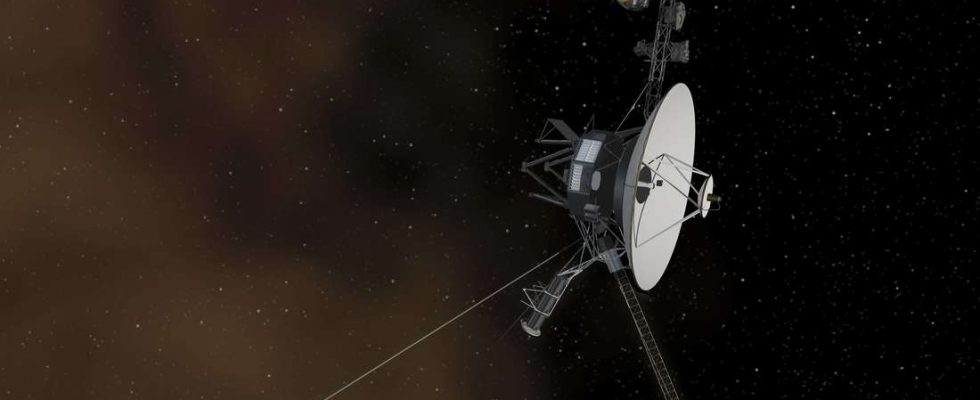Since November, NASA has had difficulties receiving data from the Voyager 1 spacecraft. Solving the problem is difficult.
Pasadena – NASA’s oldest space probe still in use, “Voyager 1”, has had technical problems since mid-November. Normally it transmits from interstellar space (current distance to Earth: about 24.3 billion kilometers) important data to the scientists at the US Space Agency. But this has no longer been the case since November. It was assumed at the time that fixing the Voyager 1 bug could take several weeks.
NASA’s Voyager 1 probe has not communicated with Earth since November
But the problem is still not resolved. NASA has on X (formerly Twitter) an update on the current status of the work: “The engineers are still working on solving a data problem on ‘Voyager 1’. We can talk to the probe and it can hear us, but this is a slow process given the probe’s incredible distance from Earth.”
The enormous distance between Voyager 1 and Earth has a significant impact on the repair work. It currently takes 22 hours and 35 minutes for a signal from Earth to reach the space probe. A possible response from the probe will take just as long to reach scientists on Earth, complicating the situation. “Voyager 1” began its journey into space in the summer of 1977 and has been leaving the solar system behind for several years.
| Voyager 1 |
| September 5, 1977, 12:56 p.m. (UTC) |
| more than 24 billion kilometers |
| 22 hours and 35 minutes |
| 4 out of 10 |
“Voyager” project manager: “We haven’t given up yet”
Suzanne Dodd, the project manager of “Voyager,” explains in one Interview with Ars Technica the difficulties: “It would be the greatest miracle if we got her back. We haven’t given up yet.” However, she remains optimistic: “There are other things we can try.” However, she adds a thought-provoking statement: “But this is by far the most serious problem since I became a project manager.” Dodd has been responsible for the Voyager space probes at NASA’s Jet Propulsion Laboratory (JPL) since 2010.
The computer problem that Voyager 1 has been struggling with for months prevents the probe from sending data to Earth. Therefore, NASA does not receive any scientific data or basic information about the spacecraft. The experts currently have no information about the space probe’s drive, the energy supply or the control systems. In December announced NASAthat the probe is just sending a “repeating pattern of 1s and 0s, as if it were stuck.”
Currently, the probe only sends a carrier tone to Earth, which signals to the NASA team that the probe is still alive. Changes in this signal show experts that “Voyager 1” is receiving the commands sent from Earth. “Unfortunately, we haven’t cracked the nut yet, haven’t solved the problem and haven’t gotten any telemetry data back,” said Dodd.
The problem with “Voyager 1” is probably due to a computer – it no longer has a backup
Since November, NASA experts have suspected that the problem with “Voyager 1” could lie with one of the three computers on board. The Flight Data System (FDS) does not appear to be communicating correctly with a subsystem called the Telemetry Modulation Unit (TMU), resulting in data not being sent to Earth, according to Nasa. Dodd and her engineering team are now “99.9 percent sure” that the problem is with the FDS. The most likely cause appears to be corrupted memory in the system.
However, the missing “Voyager” data makes the team’s work more difficult. “It’s probably in the FDS storage somewhere. A bit was swapped or damaged. But without the telemetry, we can’t see where the FDS memory is corrupted,” Dodd explains. For other components that showed signs of wear or failed over time, NASA was able to switch to backup systems in some cases. However, this is no longer possible with the FDS because the backup FDS already failed in 1981.
Will there ever be good news from NASA about “Voyager 1”?
It could be some time before there is good news from Voyager 1 again – if at all. After more than 45 years in space, it is entirely possible that the probe will never function properly again. This would be a great loss for space travel, as only a few space probes (in addition to “Voyager 1”, these are the twin probes “Voyager 2” and “Pioneer 10”) are in interstellar space. “Voyager 2” last had problems in the summer of 2023, but NASA was able to restore contact using an “interstellar scream”.
“Voyager 1” is a legend in space travel. On its long journey to the edge of the solar system, it visited several planets and provided research with a wealth of data. She also took the famous “Pale Blue Dot” photo, which shows Earth as a small, pale blue dot in vast space. (tab)
The editor wrote this article and then used an AI language model for optimization at her own discretion. All information has been carefully checked. Find out more about our AI principles here.

